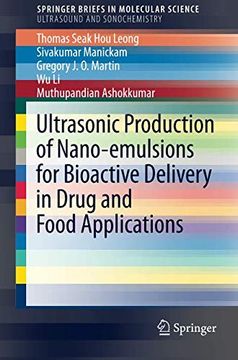Share
Ultrasonic Production of Nano-Emulsions for Bioactive Delivery in Drug and Food Applications (Springerbriefs in Molecular Science) (in English)
Thomas Seak Hou Leong; Sivakumar Manickam; Gregory J. O. Martin (Author)
·
Springer
· Paperback
Ultrasonic Production of Nano-Emulsions for Bioactive Delivery in Drug and Food Applications (Springerbriefs in Molecular Science) (in English) - Thomas Seak Hou Leong; Sivakumar Manickam; Gregory J. O. Martin
$ 47.36
$ 49.99
You save: $ 2.63
Choose the list to add your product or create one New List
✓ Product added successfully to the Wishlist.
Go to My WishlistsIt will be shipped from our warehouse between
Monday, May 20 and
Tuesday, May 21.
You will receive it anywhere in United States between 1 and 3 business days after shipment.
Synopsis "Ultrasonic Production of Nano-Emulsions for Bioactive Delivery in Drug and Food Applications (Springerbriefs in Molecular Science) (in English)"
This SpringerBrief provides an overview of ultrasonic emulsification and an update on recent advances in developing stable emulsions for the creation of novel drugs and functional foods, with a focus on bioactive delivery in these products.Emulsification is the process of combining two or more immiscible liquids to form a semi-stable mixture. These two liquids generally consist of an organic (oil) phase and an aqueous (water) phase that is stabilized by the addition of an emulsifier. Most common emulsions are of the oil-in-water (O/W) type, but can also be of water-in-oil (W/O) or even multiple emulsion types (i.e. double emulsions) in the form of water-in-oil-in-water (W/O/W) or oil-in-water-in-oil (O/W/O) phases. The formation of an emulsion requires input of energy to distribute the disperse phase in the continuous phase in small-sized droplets that are able to resist instability. There is great interest in the use of ultrasound to produce emulsions, as it is able to do so relatively efficiently and effectively compared to existing techniques such as rotor stator, high-pressure homogenization and microfluidization. The interaction of ultrasound with the hydrocolloids and biopolymers that are often used to stabilize emulsions can offer advantages such as improved stability or greater control of formed droplet size distributions.
- 0% (0)
- 0% (0)
- 0% (0)
- 0% (0)
- 0% (0)
All books in our catalog are Original.
The book is written in English.
The binding of this edition is Paperback.
✓ Producto agregado correctamente al carro, Ir a Pagar.

